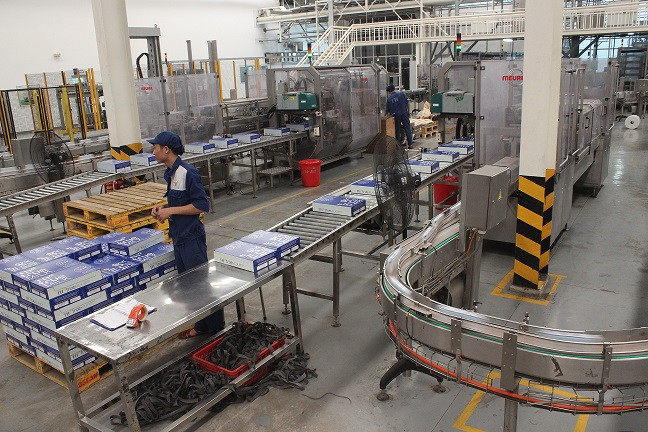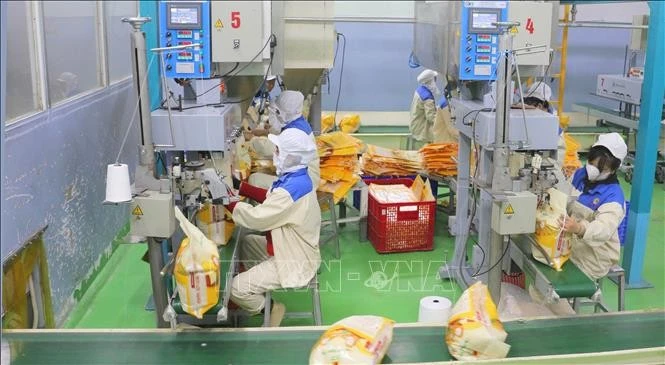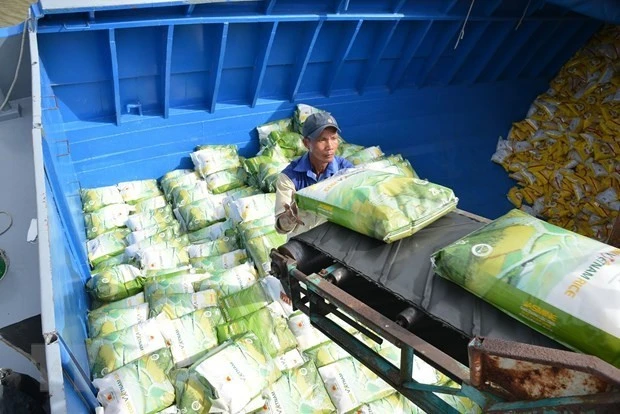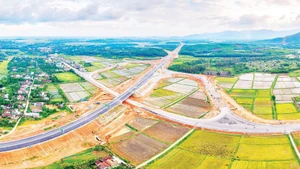“Many encouraging outcomes have been reaped in the macroeconomic picture in 2022” is a phrase that has been the most mentioned by experts and the government since last week when they evaluate the economic landscape of the year, especially in the context of increased geopolitical tensions and difficulties in global markets seriously affecting the performance of the Vietnamese economy.
The General Statistics Office (GSO) stated that owning to the government’s flexible and pliable policies on controlling the COVID-19 pandemic, supporting individuals and enterprises, and ensuring social security, and the great consensus and solidarity of all units, agencies, and localities, as well as the sharing and assistance of businesses and all people from all over the country, all economic activities in Q4 and the entire 2022 have harvested quite positive outcomes.
According to the GSO, the economy is estimated to increase 5.92% year-on-year in Q4, higher than the year-on-year rise of 5.22% in the corresponding period of 2021.
The growth rate for the entire 2022 is estimated to be 8.02%, the highest level in terms of rate in the 2011-2022 period (see box) thanks to the economy’s big recovery.
The economy ascended 5.03% for Q1, 7.72% for Q2, and 13.67% for Q3, mirroring domestic production strongly surging from 2021 when the whole nation continued suffering from resurgence of COVID-19 which seriously affected all sectors of the economy and forced many key economic hubs in the nation to halt production and business activities – especially in Q3 of 2021.
In 2022, the growth rate stands at 3.36% for the agro-forestry-fishery sector (higher than 2.58% of 2021) – responsible for 5.11% of economic growth, 7.78% for the industrial and construction sector (higher than 4.05% last year) – creating 38.24% of economic growth, and 10% for the service sector (higher than 1.22% last year) – holding 56.65% of economic growth.
Also in 2022, the processing and manufacturing industry continued to be the growth engine of the whole economy with an increase of 8.1%, contributing 2.09 percentage points to the growth rate of total added value of the whole economy. Meanwhile, water supply, management and treatment of waste and wastewater expanded 7.45%, contributing 0.04% of percentage points.
The electricity production and distribution industry climbed by 7.05%, contributing 0.26 percentage points; the mining industry ascended 5.19%, contributing 0.17 percentage points; and the construction industry increased 8.17%, contributing 0.59 percentage points.
The service sector has recovered strongly with a growth rate in 2022 reaching 9.99%, the highest in the period 2011-2022.
“Vietnam should remain ASEAN’s top performer in 2023, despite projected softer growth. Slowdowns in private consumption, investment, industrial activity and exports will all weigh on activity, but faster government spending growth, the relocation of firms from China and a revival in tourism will provide support,” said global analyst FocusEconomics.
Rebound in trade
According to the GSO, the Vietnamese economy’s commodities export-import turnover in 2022 is estimated to reach 732.5 billion USD – up 9.5% year-on-year. Export turnover sat at 371.85 billion USD – up 10.6%, while the import turnover hit 360.65 billion USD – a year-on-year rise of 8.4%. This would mean a trade surplus of 11.2 billion USD for the whole year.
Vietnam consecutively recorded a trade surplus in 2022, at 809 million USD in Q1, 1.28 billion USD in six months, 5.7 billion USD in nine months, and 10.6 billion USD after the first 11 months.
All trade achievements have been thanks to consumers’ high spending, and tax reduction and removal under free trade agreements’ commitments, the GSO said.
The key driver of the trade surplus in 2022 is foreign-invested enterprises (FIEs). Their total export-import turnover reached 511.62 billion USD, with 276.76 billion USD worth of exports (including crude oil exports) – up 12.1% year-on-year, and 234.86 billion USD in imports – a year-on-year expansion of 7.5%. FIEs’ trade surplus for 2022 touched 41.9 billion USD - up 70% from 29.36 billion USD reaped in the previous year.
According to the GSO, the biggest driver of Vietnam’s export turnover is the shipment of mobile phones and their spare parts, which stood at 59.29 billion USD, up 3.1% year-on-year. This is followed by exports of computers, laptops, and many other electronic products - with total turnover of 55.24 billion USD in 2022, an increase from 51 billion USD in 2021.
As of December 20, 2022, total registered foreign direct investment was 27.72 billion USD, a year-on-year decrease of 11%, but disbursement reached 22.4 billion USD, up 13.5% over the previous year.
In Q4, the total number of newly established enterprises in the economy was as many as 148,500, with total registered capital of 69.17 billion USD, employing around 981,300 new workers. These are up 27.1% in the number of businesses, down 1.3% in capital, and up 14.9% in workers.
“These statistics have demonstrated the fact that in spite of existing hardships, the domestic economy with its recovery in production and trade, as well as enterprises’ confidence remains resilient, laying firm groundwork for solid growth for 2023,” said GSO general director Nguyen Thi Huong.
Fresh projections
FocusEconomics forecasts that under its calculations, Vietnam’s economy will grow 7.5% in 2022 and 6.7% in 2023. This is far higher than the whole region in general and each other member state in particular, with ASEAN (5.3 and 4.4%, respectively), Brunei (2.2 and 2.7%), Cambodia (5.1-5.7%), Indonesia (5.2-4.7%), Laos (2.4-3.3%), Malaysia (7.8-4.1%), Myanmar (0.8-3%), the Philippines (6.9-5.3%), and Singapore (3.6-2%).
Over a week ago, HSBC raised its 2022 growth forecast for Vietnam from 7.6 to 8.1%, a prediction that if manifested would make the country the second fastest growing economy in ASEAN behind Malaysia.
Since the advent of the US-China trade tensions, Vietnam has been one of the biggest beneficiaries in terms of both trade and foreign direct investment diversion, boosting its export share in the US market in particular, HSBC said, but added it has revised down the forecast for next year from 6 to 5.8% due to lingering risks including trade headwinds.
Despite regional and global gloom, the Asian Development Bank (ADB) with its own calculations has revised up its economic growth forecast for Vietnam to 7.5% in 2022, from 6.5% as projected in September.
ADB experts noted that while the Vietnamese economy is now performing well amid global uncertainties, risks to the country’s economic outlook have expanded.
The bank said that although domestic trade continues to increase, there are indicators of weakening global demand for the country’s exports. Moving forward, growth for 2023 has therefore been adjusted down to 6.3% as major trade partners weaken.
The World Bank in October 2022 also predicted that the Vietnamese economy will grow 7.2% in 2022 before going down to 6.7% in 2023.
“The 7.2% growth rate is a remarkable result, particularly considering the economic slowdown experienced in the rest of the world. However, we need to acknowledge that 2023 is going to be a much more difficult year and we expect the economy to slow down during the next months, as the global economic outlook is gloomy and this is going to affect Vietnam’s economic performance,” said Andrea Coppola, lead economist at the World Bank.
Prime Minister Pham Minh Chinh also stated that in 2023, difficulties will continue to challenge the Vietnamese economy, even if there are some bright spots on the horizon.
“We are not wavering, nor subjective, neglectful and caught off guard. Instead, we must stay calm and have a firm grasp of the situation to find solutions,” he said.
Year-on-year growth GDP since 2011 (%)
(Source: General Statistics Office)
2011: 6.41
2012: 5.5
2013: 5.55
2014: 6.42
2015: 6.99
2016: 6.69
2017: 6.94
2018: 7.47
2019: 7.36
2020: 2.87
2021: 2.56
2022: 8.02



![[Video] Seven inspection teams formed to stabilise market during peak Tet period](https://en-cdn.nhandan.vn/images/9f233ae74386156ace55673ec5a8ea373e7bb5df2274800bfd51bda6ec86d9464d289201deda54c246314a974e2f0aef0bc69929884e4c53fd4eb6a1f98b468f6ae70becd9f49b834a8b9195e077c25b/anhminhhoavideo-110126-2.jpg.webp)












